人教版(2019)选择性必修 第三册Unit 1 Art Reading and Thinking 课件-(共24张PPT)
文档属性
| 名称 | 人教版(2019)选择性必修 第三册Unit 1 Art Reading and Thinking 课件-(共24张PPT) |  | |
| 格式 | pptx | ||
| 文件大小 | 27.0MB | ||
| 资源类型 | 教案 | ||
| 版本资源 | 人教版(2019) | ||
| 科目 | 英语 | ||
| 更新时间 | 2024-03-03 16:51:31 | ||
图片预览

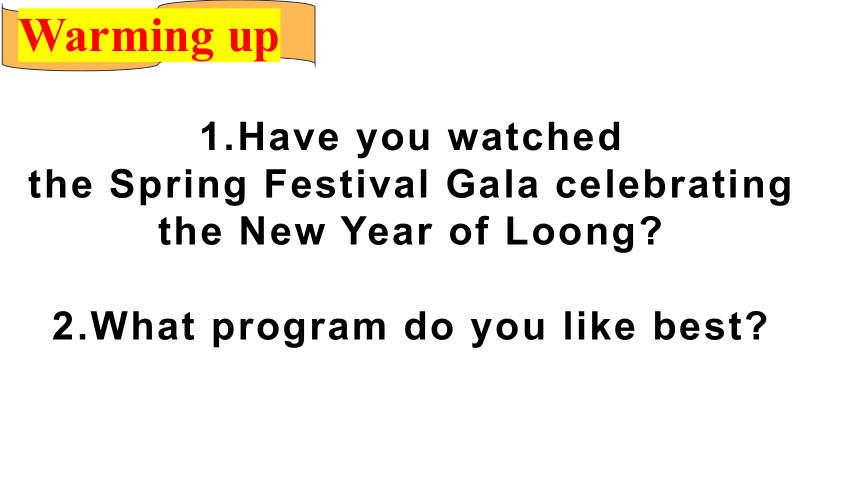
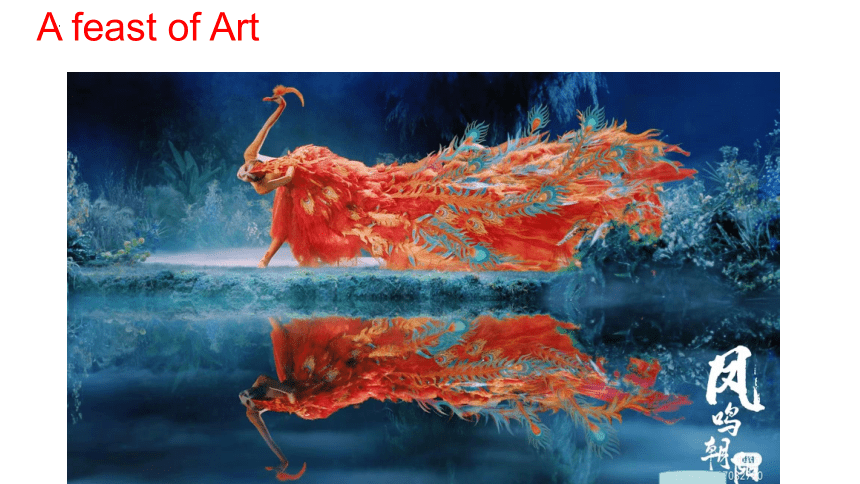
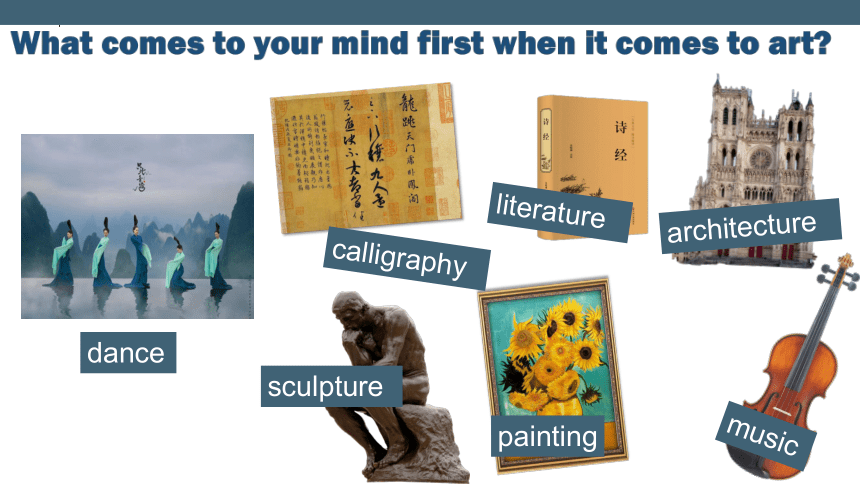
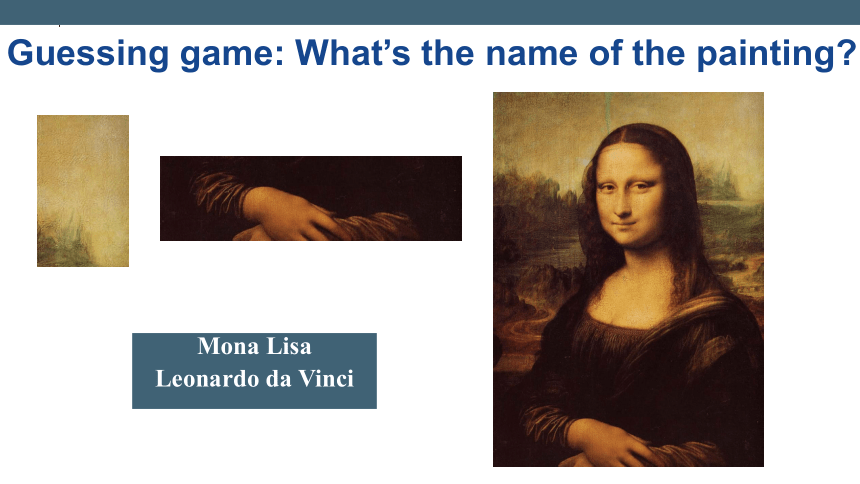
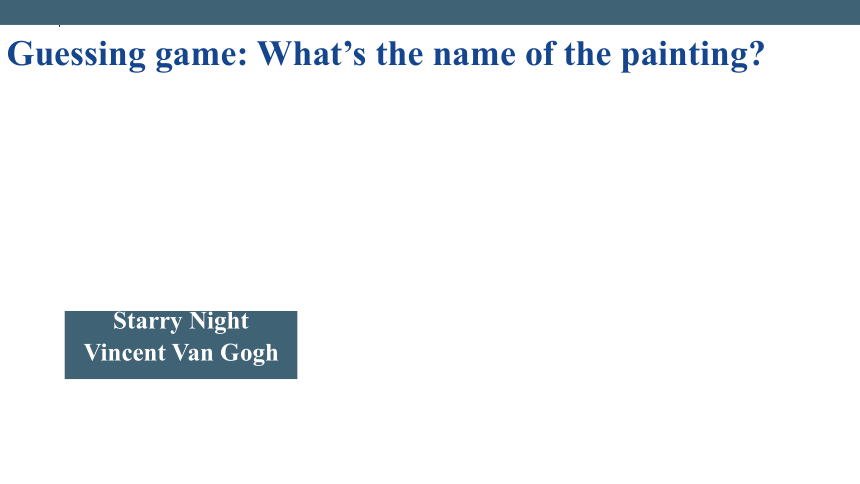
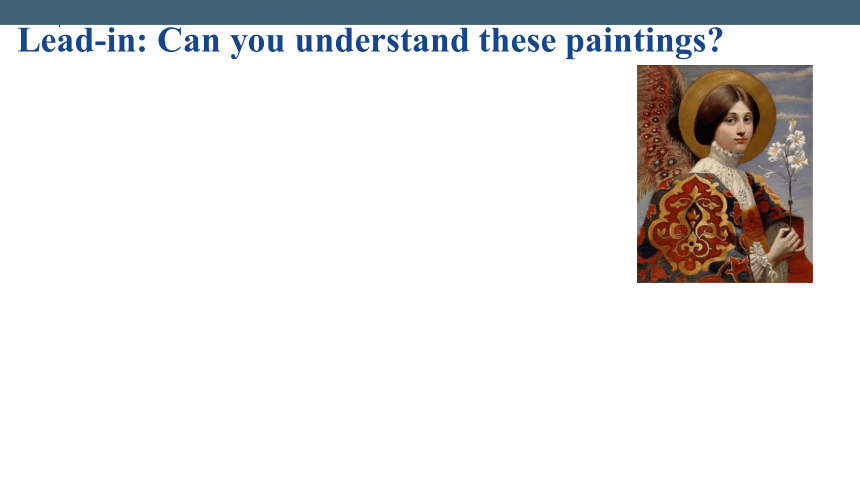
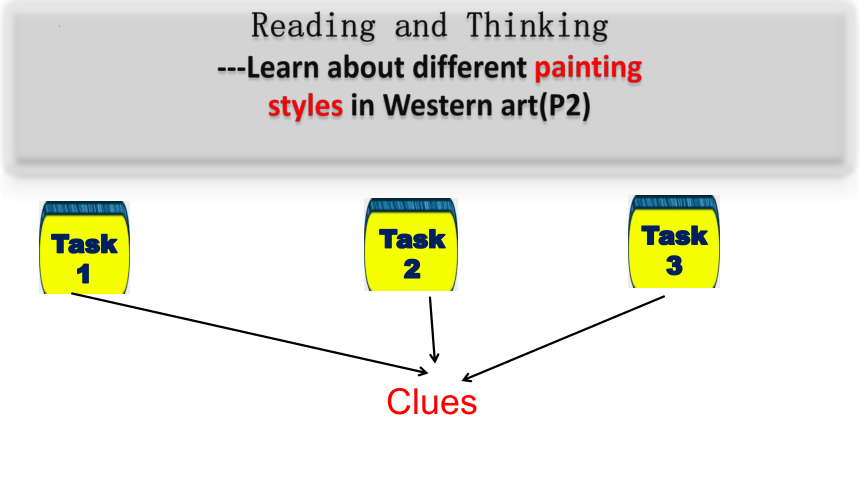
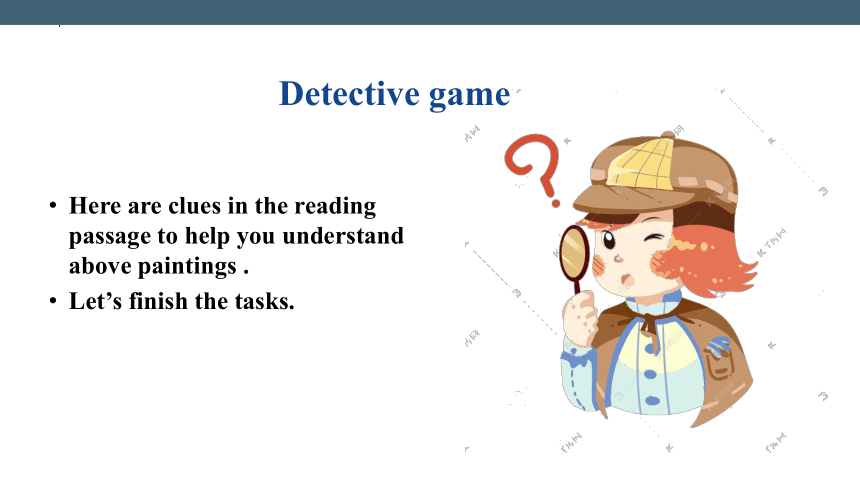
文档简介
(共24张PPT)
Unit 1 Art
A short history of western painting
Warming up
1.Have you watched
the Spring Festival Gala celebrating
the New Year of Loong
2.What program do you like best
A feast of Art
architecture
sculpture
dance
music
literature
painting
calligraphy
Guessing game: What’s the name of the painting
Mona Lisa
Leonardo da Vinci
Guessing game: What’s the name of the painting
Starry Night
Vincent Van Gogh
Lead-in: Can you understand these paintings
Reading and Thinking
---Learn about different painting
styles in Western art(P2)
Task 1
Task 2
Task
3
Clues
Detective game
Here are clues in the reading passage to help you understand above paintings .
Let’s finish the tasks.
What’s the main idea of the passage
A. Styles in Western art have changed many times .
B. The development of western painting.
C. Western paintings and artists
D. My favorite paintings
Title
Subtitles
Pictures
The 1st para
1st sentence
Title: A SHORT HISTORY OF WESTERN PAINTING
Subtitles:
The Middle Ages(中世纪)(from the 5th to the 15th century)
The Renaissance(文艺复兴) (from the 14th to the 17th century)
Impressionism (印象主义) (late 19th to early 20th century)
Modern Art (from the 20th century to today)
In the order of _________.
time
Task 1
answer the following questions:
1. What’s the function of the first paragraph
A. It tells us what is art .
B. It stresses the importance of art .
C. It introduces the topic and the purpose the passage .
D. It tells us how the Impressionist paintings developed.
Task 2
2. The author’s main purpose in writing this
passage is _____.
A. to advertise the course of painting
B. to make you amused
C. to tell you how to paint pictures
D. to introduce you some information about western painting
Task3
Read the passage and make a flow chart to show the changes in Western painting styles.
The Middle Ages
The
Renaissance
Impressionism
Modern
Art
Identify change
To help identify the changes that an article talks about, look for words that express change, such as development, breakthrough, innovation, begin, and shift, and the construction from … to …
Detailed Reading
Age Main aim Characteristic Artist
________________________ (5th to 15th century AD) to represent ______________________ still had_________ show__________ (in the 13th century) __________
__________________________ (14th to 17th century) to paint ________ ________ as they really were adopted a more ____________ attitude to life painted in ____________ Masaccio
The
Middle Ages
religious
themes
Giotto di
Bondone
religious themes
real people
Detailed Reading
Age Main aim Characteristic Artist
__________________________ (5th to 15th century AD) to represent ________________________ full of ___________ ___________ in a more __________ way (in the 13th century) ___________
______________________ (14th to 17th century) to show ________ ________ around us adopted a more ____________ attitude to life use of ____________ Masaccio
Leonardo da vinci
people and the world
perspective,oil paints
The
Renaissance
humanistic
Detailed Reading
Age Main aim Characteristic Artist
____________(late 19th to _____________________) to convey the ____________________ in the scene not a ________ record of the scene itself ____________________
____________ (20th century to today) ____________ of the object or to make the paintings look like _________ ______________ realistic ___________
early 20th century
light and movement
detailed
Impressionism
Claude Monet & Renoir
Detailed Reading
Age Main aim Characteristic Artist
_____________ (late 19th to __________________________) to show how ________________________ fell on objects at different times of the day not as ___________ as paintings of early painters controversial at first ___________
____________ (20th century to today) to analyse___________ in a new way with_________ _____________ realistic ___________
Modern Art
the shapes
abstract
Cubism
Picasso
School(流派):____________
Why: ____________________
School(流派):____________
Why: ____________________
Impressionism
Modern Art
With Cubism
Subjective impression
Detective game
School(流派):____________
Why: ____________________
School(流派):____________
Why: ____________________
The Middle Ages
Much larger main characters
The Renaissance
A portrait of a noble
School(流派):____________
Why: ____________________
School(流派):____________
Why: ____________________
The Renaissance
The use of perspective
Modern Art
Abstract Art
School(流派):____________
Why: ____________________
Impressionism
Not a detailed record
Critical thinking
Do you have clear understanding of western paintings now
What can you get from western paintings
What is art
对美的喜爱是品味。对美的创造是艺术。
—— 拉尔夫·沃尔多·爱默生
Love of beauty is taste.
The creation of beauty is art.— Ralph Waldo Emerson
Art as the creation of beauty is a process which involves a lot of motivation, energy, and effort, and of course, imagination. Having good taste and appreciating art perhaps help one’s ability to create art, and therefore beauty.
What is art
Unit 1 Art
A short history of western painting
Warming up
1.Have you watched
the Spring Festival Gala celebrating
the New Year of Loong
2.What program do you like best
A feast of Art
architecture
sculpture
dance
music
literature
painting
calligraphy
Guessing game: What’s the name of the painting
Mona Lisa
Leonardo da Vinci
Guessing game: What’s the name of the painting
Starry Night
Vincent Van Gogh
Lead-in: Can you understand these paintings
Reading and Thinking
---Learn about different painting
styles in Western art(P2)
Task 1
Task 2
Task
3
Clues
Detective game
Here are clues in the reading passage to help you understand above paintings .
Let’s finish the tasks.
What’s the main idea of the passage
A. Styles in Western art have changed many times .
B. The development of western painting.
C. Western paintings and artists
D. My favorite paintings
Title
Subtitles
Pictures
The 1st para
1st sentence
Title: A SHORT HISTORY OF WESTERN PAINTING
Subtitles:
The Middle Ages(中世纪)(from the 5th to the 15th century)
The Renaissance(文艺复兴) (from the 14th to the 17th century)
Impressionism (印象主义) (late 19th to early 20th century)
Modern Art (from the 20th century to today)
In the order of _________.
time
Task 1
answer the following questions:
1. What’s the function of the first paragraph
A. It tells us what is art .
B. It stresses the importance of art .
C. It introduces the topic and the purpose the passage .
D. It tells us how the Impressionist paintings developed.
Task 2
2. The author’s main purpose in writing this
passage is _____.
A. to advertise the course of painting
B. to make you amused
C. to tell you how to paint pictures
D. to introduce you some information about western painting
Task3
Read the passage and make a flow chart to show the changes in Western painting styles.
The Middle Ages
The
Renaissance
Impressionism
Modern
Art
Identify change
To help identify the changes that an article talks about, look for words that express change, such as development, breakthrough, innovation, begin, and shift, and the construction from … to …
Detailed Reading
Age Main aim Characteristic Artist
________________________ (5th to 15th century AD) to represent ______________________ still had_________ show__________ (in the 13th century) __________
__________________________ (14th to 17th century) to paint ________ ________ as they really were adopted a more ____________ attitude to life painted in ____________ Masaccio
The
Middle Ages
religious
themes
Giotto di
Bondone
religious themes
real people
Detailed Reading
Age Main aim Characteristic Artist
__________________________ (5th to 15th century AD) to represent ________________________ full of ___________ ___________ in a more __________ way (in the 13th century) ___________
______________________ (14th to 17th century) to show ________ ________ around us adopted a more ____________ attitude to life use of ____________ Masaccio
Leonardo da vinci
people and the world
perspective,oil paints
The
Renaissance
humanistic
Detailed Reading
Age Main aim Characteristic Artist
____________(late 19th to _____________________) to convey the ____________________ in the scene not a ________ record of the scene itself ____________________
____________ (20th century to today) ____________ of the object or to make the paintings look like _________ ______________ realistic ___________
early 20th century
light and movement
detailed
Impressionism
Claude Monet & Renoir
Detailed Reading
Age Main aim Characteristic Artist
_____________ (late 19th to __________________________) to show how ________________________ fell on objects at different times of the day not as ___________ as paintings of early painters controversial at first ___________
____________ (20th century to today) to analyse___________ in a new way with_________ _____________ realistic ___________
Modern Art
the shapes
abstract
Cubism
Picasso
School(流派):____________
Why: ____________________
School(流派):____________
Why: ____________________
Impressionism
Modern Art
With Cubism
Subjective impression
Detective game
School(流派):____________
Why: ____________________
School(流派):____________
Why: ____________________
The Middle Ages
Much larger main characters
The Renaissance
A portrait of a noble
School(流派):____________
Why: ____________________
School(流派):____________
Why: ____________________
The Renaissance
The use of perspective
Modern Art
Abstract Art
School(流派):____________
Why: ____________________
Impressionism
Not a detailed record
Critical thinking
Do you have clear understanding of western paintings now
What can you get from western paintings
What is art
对美的喜爱是品味。对美的创造是艺术。
—— 拉尔夫·沃尔多·爱默生
Love of beauty is taste.
The creation of beauty is art.— Ralph Waldo Emerson
Art as the creation of beauty is a process which involves a lot of motivation, energy, and effort, and of course, imagination. Having good taste and appreciating art perhaps help one’s ability to create art, and therefore beauty.
What is art
